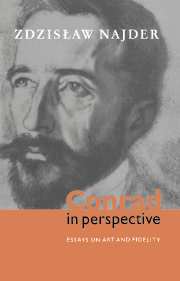Book contents
- Frontmatter
- Contents
- Acknowledgements
- Note on the texts
- List of abbreviations
- 1 Introduction, or confession of a mastodon
- 2 Conrad's Polish background, or from biography to a study of culture
- 3 Joseph Conrad's parents
- 4 Joseph Conrad and Tadeusz Bobrowski
- 5 The Sisters: a grandiose failure
- 6 Lord Jim: a Romantic tragedy of honour
- 7 The Mirror of the Sea
- 8 A Personal Record
- 9 Joseph Conrad's The Secret Agent, or the melodrama of reality
- 10 Conrad, Russia and Dostoevsky
- 11 Conrad and Rousseau: concepts of man and society
- 12 Conrad and the idea of honour
- 13 Joseph Conrad: a European writer
- 14 Joseph Conrad after a century
- 15 Joseph Conrad in his historical perspective
- 16 Fidelity and art: Joseph Conrad's cultural heritage and literary programme
- Notes
- Index
5 - The Sisters: a grandiose failure
Published online by Cambridge University Press: 07 December 2009
- Frontmatter
- Contents
- Acknowledgements
- Note on the texts
- List of abbreviations
- 1 Introduction, or confession of a mastodon
- 2 Conrad's Polish background, or from biography to a study of culture
- 3 Joseph Conrad's parents
- 4 Joseph Conrad and Tadeusz Bobrowski
- 5 The Sisters: a grandiose failure
- 6 Lord Jim: a Romantic tragedy of honour
- 7 The Mirror of the Sea
- 8 A Personal Record
- 9 Joseph Conrad's The Secret Agent, or the melodrama of reality
- 10 Conrad, Russia and Dostoevsky
- 11 Conrad and Rousseau: concepts of man and society
- 12 Conrad and the idea of honour
- 13 Joseph Conrad: a European writer
- 14 Joseph Conrad after a century
- 15 Joseph Conrad in his historical perspective
- 16 Fidelity and art: Joseph Conrad's cultural heritage and literary programme
- Notes
- Index
Summary
Joseph Conrad did not finish two of his novels: one at the beginning of his writing career, the other at its very end. The Sisters and Suspense differ in many ways. The former was quickly dropped for good, the latter occupied Conrad's mind for at least twelve years, and he kept returning to it over and over again. Compared with The Sisters, Suspense shows signs of its author's age and weariness. The narrative form of the two works is quite dissimilar. Even the faults of both stories lie at opposite poles: while the language of The Sisters errs in the direction of recherché rhetoric, that of Suspense occasionally veers into banality and glibness.
Still, the two unfinished novels have a couple of things in common. Both are thoroughly European in their background and subject, and both are imposingly ambitious in their thematic sweep. Among Conrad's completed works only Nostromo and perhaps Under Western Eyes can match the scope of Suspense.
The grandness of the design of The Sisters has been little noted so far. It was Conrad's third story; he began it immediately after completing An Outcast of the Islands in the latter part of 189 5. After the two exotic tales, Outcast and Almayer's Folly, The Sisters was an attempt at a completely different theme: Europe and the modern world. The actual writing of the piece was not easy. Edward Garnett, an experienced critic and Conrad's first ‘literary’ friend, was negative in his appraisal of the manuscript's beginning. He advised Conrad to abandon his tale of the ‘land’ and instead make use of his experiences in the tropics and on the high seas.
- Type
- Chapter
- Information
- Conrad in PerspectiveEssays on Art and Fidelity, pp. 68 - 80Publisher: Cambridge University PressPrint publication year: 1997



